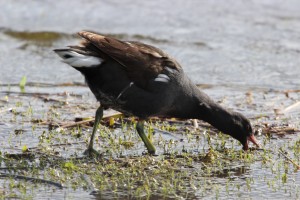 There always seems to be something mysterious or odd about moorhens and there is no better place to start to unfathom its enigma than its distribution. It is relatively common in the southern parts of Scotland but in the Highlands it is a different matter. We perhaps get used to seeing them on ponds, including those in urban parks in and around Inverness, but elsewhere they are uncommon and even rare. They breed around Inverness, on a strip of land in the north east of Caithness and in a few areas in the Western Isles but elsewhere it is very unusual. Why is difficult to say as the type of breeding sites seem to be almost widespread. The local sites where they breed include Loch Flemington, the ponds around Muir of Ord and Loch Ruthven etc. So why does it not breed in other similar sites?
There always seems to be something mysterious or odd about moorhens and there is no better place to start to unfathom its enigma than its distribution. It is relatively common in the southern parts of Scotland but in the Highlands it is a different matter. We perhaps get used to seeing them on ponds, including those in urban parks in and around Inverness, but elsewhere they are uncommon and even rare. They breed around Inverness, on a strip of land in the north east of Caithness and in a few areas in the Western Isles but elsewhere it is very unusual. Why is difficult to say as the type of breeding sites seem to be almost widespread. The local sites where they breed include Loch Flemington, the ponds around Muir of Ord and Loch Ruthven etc. So why does it not breed in other similar sites?
Moorhens can be very secretive and when disturbed they will make for the cover of nearby vegetation. However, they also have another means of escape as they will, frequently, just dive and surface nearer or in marginal plants such as sedges. We tend to think of them as water birds but they also have another unusual habit in that they will climb trees. They use their long slender looking legs and long toes to do this and they can look ungainly on the branches. However, they have another intriguing adaptation as on the elbow joint of the wing there is a small spur that they use to climb. Whilst they normally nest amidst marginal plants they will nest off the ground in low trees and will also roost in trees or shrubs.
Even the nesting habit of the moorhen is unusual as, although a single female may lay a clutch of five to seven eggs, it is not uncommon for more than one female to lay in the same nest. Sometimes two, three and even four females will lay eggs in the same nest which means up to over twenty eggs being laid. The eggs are incubated for about 21 days and then both the male and female birds will feed them and protect the chicks. By 25 days the chicks can feed themselves but even so the adults carry on feeding them until they fly at 45 days. The young do not become independent until between 52 and 99 days. Sometimes two or even three broods are raised.
Even the feeding habits of the moorhen seem unusual as you would expect a water bird to feed on plant material and they do to a certain extent eating duckweed and pondweed and seeds from sedges, docks and buttercups. Berries taken include blackberries, rose and elder. Then, unusually, the moorhens will also take worms, snails, spiders, insects, small fish and even the eggs of other birds. Moorhens generally stay at their breeding sites throughout the year but some birds migrate from northern and eastern Europe and end up in Scotland, including the Highlands. The photograph was taken using a 100-400 mm lens from the roadside at Loch Flemington and using the car as a hide. The bird was in the shallows and seemed to be scooping up insects as it walked along. The long green legs are conspicuous as are the white feathers on the flank and tail. The long toes enable the bird to virtually support itself on the top of the aquatic plants as if it is walking on the water!
Tags: highland wildlife
